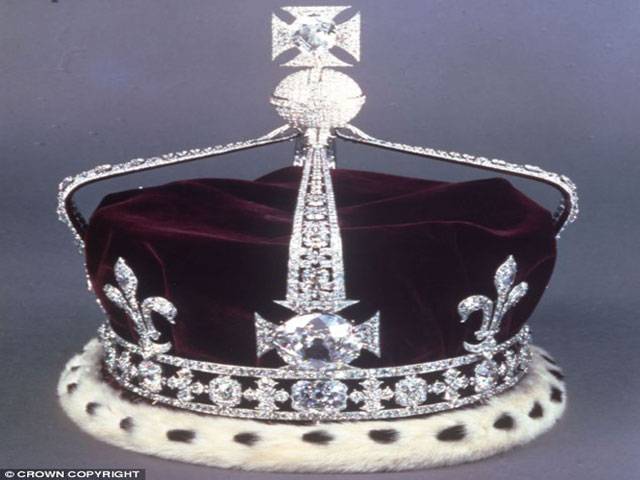INTD/AFP
New Delhi
The Koh-e-Noor saga taken another interesting turn as Indian-born British politician said the coveted diamond actually belonged to Pakistan.
‘If Koh-e-noor belongs to anybody, it belongs to Pakistan,’ Lord Meghnad Desai said while speaking to India Today. Referring to the 19th-century Sikh king Ranjit Singh, who had given the stone to the British, Lord Desai reasoned that since Singh’s seat was in Lahore, the diamond should go to Pakistan.
‘Because his territory was mainly in, what is now Pakistan – in Lahore there is a Ranjit Singh museum - it will go back to wherever the Punjab kingdom had its seat and his seat was in Lahore. So I think if it belongs to anybody, it belongs to Pakistan,’ he said.
Indian government said Tuesday that it will make all possible efforts to get back the Koh-e-Noor Diamond from Britain despite comments by New Delhi’s solicitor general that the priceless jewel should stay with the former colonial ruler. India has repeatedly demanded that Britain return the 105-carat diamond, which was presented to Queen Victoria in 1850 and today sits on display as part of the Crown Jewels in the Tower of London.
India’s solicitor general surprised many on Monday when he told the Supreme Court that his country should forgo its claims to the jewel because it was given to Britain as a gift by an Indian king in 1851, rather than stolen as many Indians today believe.
The ministry said the stone was a ‘valued piece of art with strong roots in our nation’s history’ and that Prime Minister Narendra Modi was determined to get it back. A lawyer in Pakistan last year filed a court petition calling for the stone’s return. The Koh-e-Noor is set in the crown worn by Queen Elizabeth, the mother of the reigning monarch, at the coronation of her husband George VI in 1937, and was placed on her coffin at her funeral in 2002. The Duchess of Cambridge, who last week visited India with her husband, Prince William, will wear the crown on official occasions when she becomes queen consort. William is second in line to the British throne. Moreover, India’s government was accused Wednesday of reversing its stance on the Koh-i-Noor diamond, after vowing to reclaim the priceless gem just days after the solicitor general said it was gifted to Britain.
The 108-carat Koh-i-Noor gem, which came into British hands during the colonial era, is the subject of a historic ownership dispute and has been claimed by at least four countries including India. But India’s Solicitor General Ranjit Kumar surprised many on Monday when he said the stone was not stolen, and instead 19th-century Sikh king Ranjit Singh had given it to the British.
It is now set in the crown that was worn by Queen Elizabeth’s mother until her death in 2002, and is on public display in the Tower of London. The government said Kumar had merely been explaining the history of the diamond to the Supreme Court as well as previous administrations’ views on the gem being a gift.
In a statement released late Tuesday, the government said it would ‘make all possible efforts to bring back’ the diamond ‘in an amicable manner’. ‘The Government of India remains hopeful for an amicable outcome whereby India gets back a valued piece of art with strong roots in our nation’s history,’ it also said.
Kumar had been responding in court to a petition from a non-governmental organisation seeking the diamond’s return. The main opposition Congress party, which also supports the gem’s return, accused the government of a flipflop after Kumar’s comments sparked anger from various political groups.
‘On #KohinoorDiamond, #ModiSarkar has not just done a flip-flop. It has done a full flop,’ Congress party spokesman Sanjay Jha said on Twitter, referring to Prime Minister Narendra Modi’s government. A leader of the Hindu nationalist RSS, the ideological fountainhead of Modi’s ruling party, this week declared the diamond ‘India’s property’.
The stone was presented to Queen Victoria in 1850 after the Anglo-Sikh wars in which Britain gained control of the Sikh empire of the Punjab, which is now split between Pakistan and India. Singh in turn had taken it from an Afghan king who had sought sanctuary in India. The diamond had been an heirloom of the Afghan monarchy and before then was in Persian royal hands, but its true origins remain a mystery. Its name translates as ‘Mountain of Light’ and it is traditionally worn by a queen - it is said to bring bad luck to any man who wears it. In 1976 Britain refused a request to cede the diamond, citing the terms of the Anglo-Sikh peace treaty.
Saturday, April 20, 2024
Koh-i-Noor belongs to Pakistan, says British politician
I India takes u-turn on diamond

3:56 PM | March 28, 2024
4:14 PM | March 23, 2024
Pak economy improving, funds will be provided on request: IMF
9:57 PM | April 19, 2024
Minister advocates for IT growth with public-private collaboration
9:57 PM | April 19, 2024
Judges' letter: IHC seeks suggestions from all judges
9:55 PM | April 19, 2024
Formula 1 returns to China for Round 5
9:05 PM | April 19, 2024
Germany head coach Julian Nagelsmann extends contract till 2026 World Cup
9:00 PM | April 19, 2024
A Tense Neighbourhood
April 19, 2024
Dubai Underwater
April 19, 2024
X Debate Continues
April 19, 2024
Hepatitis Challenge
April 18, 2024
IMF Predictions
April 18, 2024
Kite tragedy
April 19, 2024
Discipline dilemma
April 19, 2024
Urgent plea
April 19, 2024
Justice denied
April 18, 2024
AI dilemmas unveiled
April 18, 2024
ePaper - Nawaiwaqt
Advertisement
Nawaiwaqt Group | Copyright © 2024





